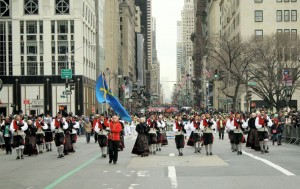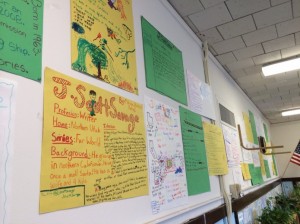2016-2017
April
Students in Ms. Adriance’s class are practicing the art of commenting online. We’ll be using the TAG approach (Tell something you like, Ask a question and Give a Suggestion).
We’ll be using El Deafo by Cece Bell as our catalyst to our conversation:
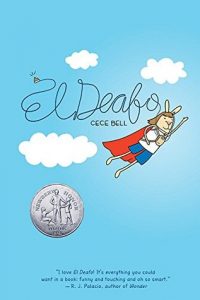 Starting at a new school is scary, even more so with a giant hearing aid strapped to your chest! At her old school, everyone in Cece’s class was deaf. Here she is different. She is sure the kids are staring at the Phonic Ear, the powerful aid that will help her hear her teacher. Too bad it also seems certain to repel potential friends.
Starting at a new school is scary, even more so with a giant hearing aid strapped to your chest! At her old school, everyone in Cece’s class was deaf. Here she is different. She is sure the kids are staring at the Phonic Ear, the powerful aid that will help her hear her teacher. Too bad it also seems certain to repel potential friends.
Then Cece makes a startling discovery. With the Phonic Ear she can hear her teacher not just in the classroom, but anywhere her teacher is in school–in the hallway…in the teacher’s lounge…in the bathroom! This is power. Maybe even superpower! Cece is on her way to becoming El Deafo, Listener for All. But the funny thing about being a superhero is that it’s just another way of feeling different… and lonely. Can Cece channel her powers into finding the thing she wants most, a true friend?
This funny perceptive graphic novel memoir about growing up hearing impaired is also an unforgettable book about growing up, and all the super and super embarrassing moments along the way.
February/March
4th and 5th grade students will be spending the months of February and March learning about 4 specific African American Artists. Resources for research are listed below.
Jacob Lawrence
Faith Ringgold
- Wikipedia
- Makers – Watch all 4, beginning with the first
- Google Images
Romare Beardon
Alma Thomas
October
Over the next couple of weeks our 4th and 5h grade students will be working to gather objective facts about both candidates (from the 2 major parties) for President of the United States. We’ll be using a simple google form to compile and share our findings.
More than ever, in this very divisive political climate, we find a greater need to search for facts first and then use those facts to drive our political conversations at home.
- Facts about Donald Trump
- Facts about Hillary Clinton
September
To begin the year, I have the pleasure of collaborating with Ms. McNeer (our art teacher) on a unit that explores using data to inform and inspire art. Laurie Frickserves as our mentor artist for this unit.
To begin our unit we will take a sample survey to begin to think more specifically about questions we might ask, data we might collect and how this process will inform and inspire our artwork.
4/5, 3/4 classes will be posting their surveys here to aid in collecting a large enough sample of data:
2015-2016
April 2016
 To celebrate poetry month, students in Ms. Manley, Ms. Outhouse, and Ms. Filep’s classes have used our library’s collection, along with the Book Creator app to create Book Spine Poems. Enjoy!
To celebrate poetry month, students in Ms. Manley, Ms. Outhouse, and Ms. Filep’s classes have used our library’s collection, along with the Book Creator app to create Book Spine Poems. Enjoy!
| Ms. Manley | Fairy |
Bagley Peace Prize 6 March – ?
Each week, 5th grade students from rooms 5, 8 and 213 come to the library to work collaboratively on Current Events. We are now moving on to more in depth research in preparation for highlighting nominees for the first annual Bagely Peace Prize. Thanks to Andy Plemmons for his guidance and inspiration!
After selecting and researching a notable person, students will write and record their nomination video to be shared via FlipGrid. Our researchers will then solicit votes from our DBE Community (forthcoming Google Form) and Beyond to tabulate and eventually award the winner the Bagley Peace Prize.
Our Bagley Peace Prize will be awarded to the candidate that exemplifies the following criteria: dependable, kind peaceful, determined, modest, fair, brave, loyal, honest, respectful and helpful.
Students will be selecting from the following persons of note:
| Walter Dean Myers | Virginia Hamilton |
| Langston Hughes | Rachel Carson |
| Frida Kahlo | Kadir Nelson |
| Wilma Rudolph | Jim Thorpe |
| Mae Jemison | Ellen Ochoa |
| Jonas Salk | Jane Adams |
| Mary McLeod Bethune | John Muir |
| Rachel Carson | Ruby Bridges |
| Sandra Day O’Connor | Hector P. Garcia |
| Thurgood Marshall | Booker T. Washington |
| Duke Ellington | Marian Anderson |
| Michelle Obama | Jane Goodall |
| Mario Molina | Juliette Gordon Low |
| Bessie Coleman | Wilma Mankiller |
| Charles Drew | Cesar Chavez |
| Henry Cisneros | Garrett Morgan |
| Delores Huerta | Jesse Owens |
| Dr. Seuss | Milton Hershey |
When you having completed your video planning document you will be able to record your FlipGrid video here.
29 February – 1 April – March Book Madness
For the second time, DBE Readers will be participating in a worldwide March Book Madness. Thanks to the Nerdy Book Club, all DBE readers have the opportunity to help seed (select) 16 participants (books) to compete in a bracket modeled after NCAA’s March Madness. The theme for 2016 is FANTASY vs. FICTION.
Brackets are available for Picture Books, Middle Grade Readers and Young Adult Titles. DBE Readers will be looking solely at the Pictures Books Bracket. Thanks to our DBE PTA, and their Special Initiatives Grant, we will have 3 copies of each MBM title available!
If your student would like to submit their selections, independent of our school wide selections, they can simply use the Picture Books Form (available after March 1). Of course, 4/5 students are encouraged to explore the Middle Grade Reader Titles, all of which are also available in our DBE Library.
Let the Games Begin!
CCSS – RF.4.4, RF.5.4 We can read with sufficient accuracy and fluency to support comprehension.
1 February 2016 – Voting Rights and the Common Good
After 4 weeks of research and production, Rm’s 209 and 7 have compiled their own eBooks on Voting Rights and the Common Good. Enjoy!
November 2015 – Parades and the Common Good
September 17 – October 9
 One of the joys of the new flexible schedule in the DBE Library is that I can directly support students in their classrooms! Ms. McNeer and I have teamed up to give students an authentic experience that allows them to create Still Life as David Hockney has – using an iPad drawing App.
One of the joys of the new flexible schedule in the DBE Library is that I can directly support students in their classrooms! Ms. McNeer and I have teamed up to give students an authentic experience that allows them to create Still Life as David Hockney has – using an iPad drawing App.
Bagley 4th and 5th grade students are working with paper and pencil first and then moving their art experience to the iPad and, in particular, the Colored Pencils App. In addition to the more obvious connections to art and the art of David Hockney, students also are using technology in ways that build strong understanding of technology as a tool to support and enhance learning. In addition to the art goals for the unit, students are also learning about file structures, naming conventions, sharing cloud spaces, how to troubleshoot technological glitches when things don’t work as planned.
2014-2015
May 18 – June 5
Students are synthesizing their notes and writing persuasive letters to the President of the United States recommending a woman be placed on the $20 bill in lieu of President Andrew Jackson. Of course, students who have completed their research and would prefer to leave the $20 as is have that option as well. Student who choose to leave the bill as is simply write a letter explaining why they would like US Currency to stay as it is.
Students are using iPads and apple keyboards (brought to you by SPS and the SBAC) to type up their formal business letters to the President. We are addressing our envelopes and mailing them from school. Students are using their home addresses for the formal correspondence so that any responses from 1600 Pennsylvania Avenue might be sent to the appropriate location.
CCSS W.4.7, W.5.7 We can conduct short research projects that build knowledge through investigation of different aspects of a topic.
W.4.9, W.5.9 We can draw evidence from informational texts to support analysis, reflection and research.
April 27 – May 15
For our final project this year we are following the Women on the 20 Movement. This project is an excellent opportunity to 4th and 5th grade students to synthesize all of their learning this year. Students begin by evaluating the full field of applicants that had been proposed by the Women on the 20 organization. Students narrow their top 3 selections down and then use 2 criteria to select their top candidate.
- What was their impact on society
- How hard was it for each woman to achieve their goals.
Once a top candidate is selected, students use both the Women on the 20 website, along with the Online World Book Encyclopedia, to gather facts to support their candidate.
CCSS RI.4.9, RI.5.9 We can integrate information from two texts on the same topic in order to write or speak about the subject knowledgeably.
March 30 – April 24
Students have now moved into the publication phase of our project. For publication, students will choose from either StoryKit or Keynote. Most 4/5s have an introductory understanding of Keynote from our earlier work with info graphics. Storykit, however is a new option for students.
CCSS
RI.4.9, RL.5.9 – We can integrate information from two/several texts on the same topic in order to write or speak about the subject knowledgeably.
SL.4.5, SL.5.5 – We can include makes strategic use of digital media and visual displays of data to express information and enhance understanding of presentations.
March 9 – 27
Students have been focusing on perseverance and stamina as researchers. I heard a lot of “it doesn’t say,” and “I’ve already found everything.” We need to be reminded and allowed to practice close reading and information selection. For this reason, not every class has progressed at the same rate. That being said, we are going to begin this session finishing up our biographical research.
Once information has been gathered from our Rookie Readers’ Biographies and World Book Online (Students Edition), each student will complete an e-book planning guide. Information from their initial graphic organizer will be sorted and selected in order to plan for the creation and publication of an e-book.
For publication, students will be able to choose from either StoryKit or Keynote. Most 4/5s have an introductory understanding of Keynote from our earlier work with info graphics. Storykit, however will be a new option for students.
CCSS
RI.4.9, RL.5.9 – We can integrate information from two/several texts on the same topic in order to write or speak about the subject knowledgeably.
SL.4.5, SL.5.5 – We can include makes strategic use of digital media and visual displays of data to express information and enhance understanding of presentations.
February 18 – March 6
For the first time, DBE Readers will be participating in a worldwide March Book Madness. Thanks to the Nerdy Book Club, all DBE readers have the opportunity to help seed (select) 64 participants (books) to compete in a bracket modeled after NCAA’s March Madness.
We are using classtime to READ BOOKS! It has be a phenomenally  enjoyable experience for everyone and our 4/5s are at the perfect age to relive the joys and wonders of picture books. Each student is starting with a list of their top ten from each side of the bracket. We are using that to calculate our totals and submit our school-wide response. Students are cheering for their favorite stories!
enjoyable experience for everyone and our 4/5s are at the perfect age to relive the joys and wonders of picture books. Each student is starting with a list of their top ten from each side of the bracket. We are using that to calculate our totals and submit our school-wide response. Students are cheering for their favorite stories!
Brackets are available for Picture Books, Middle Grade Readers and Young Adult Titles. DBE Readers will be looking solely at the Picture Books Bracket.
If your student would like to submit their selections, independent of our school wide selections, they can simply use the Picture Books form and list their top ten titles for each of the 2 categories (2014 and before 2014).
CCSS – RF.4.4, RF.5.4 We can read with sufficient accuracy and fluency to support comprehension.
January 26 – February 13
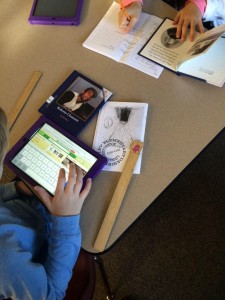 Practice, Practice, Practice! Or “good better best, never let it rest, until your good is better and your better is best!” We are continuing to present ourselves with information right resources, reading those resources and extracting relevant/important information from them. This is a major focus for 4/5s are we prepare to move them on to Middle School where the use of the library and its resources are much less structured.
Practice, Practice, Practice! Or “good better best, never let it rest, until your good is better and your better is best!” We are continuing to present ourselves with information right resources, reading those resources and extracting relevant/important information from them. This is a major focus for 4/5s are we prepare to move them on to Middle School where the use of the library and its resources are much less structured.
We have started a biographies unit. Students start by choosing from our collection of Rookie Readers Biographies. While this series ranges in reading level from first to second grade it serves as an excellent resources for starting our biographical journey. Students read the book on our first day together and then use the remaining time to identify and record
- Name, date of birth and death
- Early Life
- Why is this person important/influential
- Where have they lived/been
- adjectives that describe character traits
- additional important or interesting information
After we have exhausted our print resources we are moving to our iPads to use World Book Student and World Book Advanced, to fill in our gaps and add any additional information that we have found in our digital sources. Students are being directed to the SPS Student Resources Page to find databases that are available to them as Seattle Schools Students.
CCSS
RI.4.9, RL.5.9 – We can integrate information from two/several texts on the same topic in order to write or speak about the subject knowledgeably.
January5-23
In January we are using our time together in the library to introduce and practice the use of a PED (Personal Electronic Device) as a tool while at school. In particular, we are fortunate enough to have a full class set of iPads available to us.
All DBE students, K-5, agree to the following:
I will only use the iPad for its
intended purpose.
And if I don’t,
I will not use the iPad.
While the use of technology to enhance, enrich and support our work as students is vital to our continued growth as 21st century digitial citizens, it still stands that the use of the iPads at DBE is a privilege and not a right. The agreement above, coupled with our conversations in class prior to using the iPads illustrates how our use of PEDs at home is often guided by different principles than our use of PEDs at school. We draw the line between home/entertainment and school/education.
Each grade level is using the iPads in different ways to practice our in school protocols and procedures. Every students is assigned an iPad color and number that will be their iPad for the remainder of the school year. This helps to streamline distribution and collection as well as follow up with a user when an iPad has any issues regarding condition or content.
Our 4/5s have been using the iPads for some time now while our K-3/4s are using this time to acclimate themselves to a library that offers them access to iPads as a resource. You students are using the iPads to navigate to the DBE Library Blog and then the Library’s Catalog. Using the catalog and our “Narrow your Search” strategies, students are creating a list of “Books on Deck” in the Field Journals. This list of on Deck Books will then help to facilitate all school check out on Tuesdays AND gives us a great place to begin to expand our interests. For many of our students, using the Library’s Catalog to find the title, author and call # is a skill we still need to practice.
If you have questions or concerns about student use of iPads at DBE, please feel free to contact me: rlwynkoop@seattleschools.org.
December 1-19
 “From little things come big things” – Hal (Gail) Halvorsen
“From little things come big things” – Hal (Gail) Halvorsen
As we move away from guided note taking and extraction of information from text (both narrative and expository), students are being asked to be more independent in their selection of information to record in their Sketchbooks. For this unit we are continuing to work on selecting and extracting information from text as well as comparing and contrasting two non-fiction, narrative stories.
Using the following resources (both print and electronic):
students are recording pertinent information in their  Sketchbooks, dates, names, facts, quotes, etc. After completing the reading and viewing the related media we are engaging in a discussion about the themes of each story, the similar and different details, the historic significance and the relevancy to all of our lives.
Sketchbooks, dates, names, facts, quotes, etc. After completing the reading and viewing the related media we are engaging in a discussion about the themes of each story, the similar and different details, the historic significance and the relevancy to all of our lives.
While both stories contain the word Christmas we talk specifically about what Hal Halvorsen’s Dad used to say to him, “From little things come big things.” We talk about Diwali, Hanukkah, Kwanza and other winter time holidays and celebrations and the themes that run throughout each of those celebrations.
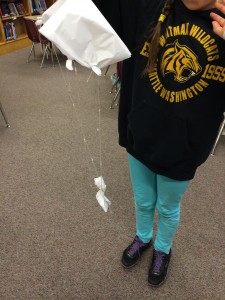 Our culminating event for this unit requires us to follow the instructions in the back of the Candy Bomber book – instructions for making parachutes just like the parachutes dropped into Berlin in 1948.
Our culminating event for this unit requires us to follow the instructions in the back of the Candy Bomber book – instructions for making parachutes just like the parachutes dropped into Berlin in 1948.
CCSS
RL.4.9 We can compare and contrast the treatment of similar themes and topics and patterns of events in stories, myths, and traditional literature from different cultures.
RL.5.9 We can compare and contrast stories in the same genre on their approaches to similar themes and topics.
November 3 – 21
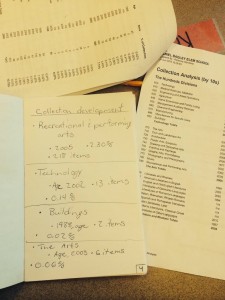 Our 4/5s are doffing their librarian’s hats for the week and diving into our collection development data! Woohoo! Students are given 6 pages from an 18 page collection analysis. They are working through the data to identify a minimum of 3 areas of focus in our non-fiction collection. Data provided and disaggregated include: % of collection, total number of books by dewey, and average age.
Our 4/5s are doffing their librarian’s hats for the week and diving into our collection development data! Woohoo! Students are given 6 pages from an 18 page collection analysis. They are working through the data to identify a minimum of 3 areas of focus in our non-fiction collection. Data provided and disaggregated include: % of collection, total number of books by dewey, and average age.
Once students have identified and recorded a minimum of three areas of focus in their Sketchbooks, they can then use the iPad to log in to our collection development software. This software allows real time decisions connected directly to our library’s catalog. Students are then able to use their data and their understanding of books students in our school would like to make collection development decisions that will lead directly to the purchase of their selections for our school library’s collection.
CCSS W.4.9, W.5.9 Draw evidence from literary or informational texts to support analysis, reflection and research.
October 13 – October 31
Students are continuing to Set the Scene of Jacqueline West’s Elsewhere series using our iPads (Safari, Photos and Keynote). Students have been asked to identify 5-7 specific scene setting phrases from the first few chapters of Book 1, The Shadows. Keynote currently serves as our software that enables us to compile our 1 page info graphic.
In addition to our continued preparation for Ms. West’s visit, we are taking a little time to engage in a time honored (all of the last 2 years) tradition in the DBE Library, Literary Pumpkins. Students are given a blank pumpkin and asked to turn that pumpkin into their favorite literary characters. Favorite characters often include Harry Potter, Bad Kitty, Gerald and Piggie Pigeon and Pokemon.
CCSS
RL.4.3, RL.5.3 I can describe, in depth, a setting in a story drawing on specific details in the text.
W.4.6, W.4.6 I can use technology, including the internet, to produce and publish.
September 22 – October 10
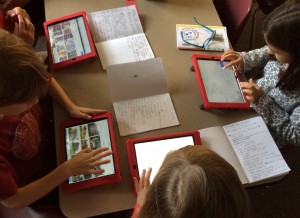 Jacqueline West, author of the Elsewhere Series, will be coming to Bagley to talk with our 4th and 5th grade students about her newest book in the series. We have begun to prepare for her arrival!
Jacqueline West, author of the Elsewhere Series, will be coming to Bagley to talk with our 4th and 5th grade students about her newest book in the series. We have begun to prepare for her arrival!
CCSS
RL.4.3, RL.5.3 I can describe, in depth, a setting in a story drawing on specific details in the text.
W.4.6, W.4.6 I can use technology, including the internet, to produce and publish.
September 1-19
Library Schedules have changed this year!
First, all school library checkout will occur on Tuesdays! Students should bring back their books for collection Tuesday mornings and families should be able to ask “What new book did you check out of the library?” at the end of the day.
Second, the DBE PCP schedule (visits to Art, PE, Tech, and Library) has moved to an ABC rotation. One week your student will attend art 5 days a week for 40 minutes, then PE for 5 days for 40 minutes and the third leg of the rotation is 2 days on technology followed by 2 days of library (each visit for 40 minutes).
For the first 2 visits of library this year, the 4/5 and 5 classes came to the library and reviewed library policies and procedures as well as classroom expectations.
In order to build our sense of community and to serve as a visual reminder that the library is shared by everyone, each student colored a bumble bee with their name on it. This was done K-5 and by all school staff.
Lastly we spent some time creating and organizing our Sketchbooks. 4/5 students will be using their sketchbooks throughout the year to keep library/information literacy related work in one location. Sketchbooks stay in the library but will be sent home at the end of the school year. We began our sketchbooks with a Table of Contents and a list of “Books I’ve Read” (over the summer).
CCSS
SL.4.1, SL.5.1 I can engage effectively in a collaborate discussion.
2013-2014
May 21-23
SPRING BOOK FAIR this week! Wednesday, Thursday and Friday this week we will be hosting a Spring Book Fair in the library. Students will be given the opportunity to browse the selecetion, brought to us by the University Bookstore, and make wish lists to share with the loving adults in their lives. Book Fair will be open for purchases each day after school.
May 14-16
Hoping that our iPads come in this week, we will spend most of our time talking and working through how we use technology at school. iPads offer a great incentive for students to dig in and get to work but also make it very easy to get distracted while working independently in the library. Prior to using the iPads for our info graphic creation, we will review expectations with regard to both technology use and independent time – specifically while using technology at school.
CCSS SL.4.1, SL.5.1 – Comprehension and Collaboration: Engage effectively in a range of collaborative discussions with diverse partners on grade 4 or 5 topics and texts, building on others’ ideas and expressing their own clearly.
May 7 – May 9
This week we are reading Jim Henson: The Guy Who Played With Puppets by Kathleen Krull. We will be continuing our quest for accurate and relevant information. This narrative non-fiction text provides an additional access point for students, through prose and pictures, that enhances our ability to validate information. Pictures from today’s text are presented via Keynote. Students will be using Keynote to create an info graphic using the information they have gained from our research.
CCSS W.4.7, W.5.7 Research to Build and Present Knowledge – Conduct short research projects that build knowledge through investigation of different aspects of a topic.
April 30 – May 2
This week we are returning to our research topic, Jim Henson and his influence. We began with key word creation, basic initial internet research, reading and article about Jim Henson and now we are spending about 15 minutes today recording information gleaned from the Muppet documentary: Of Muppets and Men: The Making of the Muppet Show.
CCSS W.4.7, W.5.7 Research to Build and Present Knowledge – Conduct short research projects that build knowledge through investigation of different aspects of a topic.
April 23-25
This week we have the pleasure of stepping back from our research and focusing on sharing book projects recently completed by Mr. Moore and Ms. Stackhouse’s classes. Thanks to all the students who came in to share their book projects and allow our listeners to provide positive and productive feedback related to their presentations!
CCSS SL.4.1, SL.5.1 – Comprehension and Collaboration: Engage effectively in a range of collaborative discussions with diverse partners on grade 4 or 5 topics and texts, building on others’ ideas and expressing their own clearly.
April 9-11
We are continuing to gather information to help us better prepare ourselves for research. Last week we used the internet as a starting point and began collecting search terms/keywords. This week we are continuing in this vain using an article/New York Times Book Review titled “Muppet Man” by John Swansburg. Students begin by adding this title and author to their papers before adding new search terms/keywords culled from this article. Jim Henson and his influence on entertainment and education is the focus of our research.
As I read the article, students follow along and I think outloud as I skip the particularly solacious paragraph about Mr. Henson’s personal life. We talk specifically about how researchers choose what information is needed and what is not. In this instance, Jim Henson’s marriage is of no use to us as researchers. After reading the article we collected keywords as a class.
CCSS W.4.7, W.5.7 Research to Build and Present Knowledge – Conduct short research projects that build knowledge through investigation of different aspects of a topic.
April 2-4
Our J. Scott Savage research over the past 3 weeks was an excellent authentic pre-assessment focused specifically on our research skills when using the internet. We are now going to dive into mini lessons intended to target some of the more glaring gaps in our knowledge and researchers in the 21st century.
This week we are going to start with the basics – keyword creation and use. We will be using the library iPads and computers to put our keyword skills to the test.
CCSS W.4.7, W.5.7 Research to Build and Present Knowledge – Conduct short research projects that build knowledge through investigation of different aspects of a topic.
March 26-28
This week we were thrilled to host J. Scott Savage in our library. Our DBE readers had been working in small groups for 3 weeks to prepare for his visit. Collectively we created quite a list of questions that we wanted to ask. The research posters that served as a pre-assessment for Ms. Wynkoop also served as a source of humor for Mr. Savage. There were definitely some inaccuracies in our research. For example, he is not divorced – his lovely wife Jennifer accompanied him on his visit and he was most certainly NOT born on a whaling ship!
Thank you so much for J. Scott Savage and Terry at the Northgate Barnes and Noble for making this visit possible. I had the joy of delivering 21 personalized and signed copies to some very excited DBE readers today!
March 19-21
Next week we will be joined by J. Scott Savage! This week we are continuing our research of Mr. Savage and beginning to prepare questions that we might ask Mr. Savage about his work and life.
CCSS RI.5.7 – Integration of Knowledge and Ideas: Draw on information from multiple print or digital source, demonstrating the ability to locate an answer to a questions quickly or to solve a problem efficiently.
CCSS RI.4.9 – Integration of Knowledge and Ideas: Integrate information from two texts on the same topic in order to write or speak about the subject knowledgeably.
March 12-14
We are continuing our research on J. Scott Savage and looking forward to his presenation on Friday March 28th!
CCSS RI.5.7 – Integration of Knowledge and Ideas: Draw on information from multiple print or digital source, demonstrating the ability to locate an answer to a questions quickly or to solve a problem efficiently.
CCSS RI.4.9 – Integration of Knowledge and Ideas: Integrate information from two texts on the same topic in order to write or speak about the subject knowledgeably.
March 5-7
I just found out this week that the DBE Library will be hosting author J. Scott Savage on Friday March 28th. Mr. Savage will be coming to talk with our 4th and 5th grade classes about his latest book in his FarWorld series.
In order to prepare for his visit AND to allow me to pre-assess our 4/5s with regard to their research skills, students were given a very simple task this week, “Who is J. Scott Savage.” Small groups were given an iPad, one computer and a large piece of paper to begin to record their information. We will be working on this for at least another week as we prepare for Mr. Savage’s arrival. This is an excellent opportunity for me to observe their current research strategies and deceision making processes with regard to information gathering. I will use this information as we move into a more research focuses unit to prepare our 5th grade students for middle school.
CCSS RI.5.7 – Integration of Knowledge and Ideas: Draw on information from multiple print or digital source, demonstrating the ability to locate an answer to a questions quickly or to solve a problem efficiently.
CCSS RI.4.9 – Integration of Knowledge and Ideas: Integrate information from two texts on the same topic in order to write or speak about the subject knowledgeably.
February 26-28
We did it! This week we finally managed to reach a critical mass of students and we have finished our Dichotomous Keys! Each class used their notes (both individual and group) to identify the dichotomy for each story related to our original questons:
- Who are the characters in the story
- What happens in this story that is important
- Where does this story take place
- When does this story take place
- Why is this story important
- How does this story end
While I acted the notetaker, students collectively identified the dichotomies that exists between the two stories and we recorded them in a word Table. We used our dichotomous Candy key as a reference for finding similarities and differences. At the end of the week I will post documents that encompass our entire process. Oh such great DICHOTOMY!
I am really proud of the way our 4/5s stuck with this unit. We started reading and taking notes back in December and thankfully have finished before the end of February!
CCSS W.4.9, W.5.9 Research to Build and Present Knowledge – Draw evidence from literary or informational texts to support analysis, reflection, and research.
February 12-14
This lesson was originally planned for the previous week (February 5-7). Due to the collaborative nature of the culminating project and both the decreased attendance due to the Seahawks parade and a PNB field trip we will be completeing our Dichotomous keys this week. This is the week that we come back together as a class with our data from our folktales. We will be building a collective dichotomous key to help us identify the differences between our two winter folktales (Father Frost and The Twelve Brothers).
CCSS W.4.9, W.5.9 Research to Build and Present Knowledge – Draw evidence from literary or informational texts to support analysis, reflection, and research.
February 5-7
Due to a Seahawks parade, decreased attendance and a PNB fieldtrip this week we have postponed our culminating acitivity for our dichotomous keys. We did, however, use this time to step back and re-evaluate our reading goals set in November. To help those students who were struggling with their initial goals we played Reading Bingo prior to reviewing our goals. This creative form of Bingo provided numerous places for students to engage with each other regarding their reading – recommendations were flying across the room! I would encourage you to check this Bingo card out and play as a family. Working towards a “blackout board” as a family would be a great way to learn about what your students have been reading at school too.
CCSS RL.4.5, RL.5.5 Craft and Structure – Students must read widely and deeply from a broad range of high-quality, increasingly challenging literary and informational texts.
January 29-30
This week we are wrapping up our data gathering and beginning to construct our dichotomous keys. Students will be bringing their data back to the whole class to share, in an effort to ensure our data is accurate and complete. Each 4/5 class will make their own dichotomous key.
CCSS RL5.9, RL.4.9 – Integration of Knowledge and Ideas,
January 22-24
More work this week on our Dichotomous Keys. We are still gathering information from our notes into our records sheets. Group work in a 4/5 classroom is challenging but we are making great strides.
January 15-17
In December we read two winter folktales, Father Frost and The Twleve Brothers. Whiles students listened to each story they took notes on a sheet of paper divided into two columns. This week we have come back to our foktales and are beginning to gather information from our notes to create a dichotomous key for the two stories that we read. Students are working in small groups to comb through their notes and answer the following:
- Who are the characters in the story
- What happens in this story that is important
- Where does this story take place
- When does this story take place
- Why is this story important
- How does this story end
This group work is a fairly slow process. With students working together, we hopw to complete our data collection next week. In addition, our 30 minute library time each week only allows for 10 (sometimes 15) minutes to work on our lessons each week. The rest of the class period is reserved specifically for looking for just right books and checking them out.
January 8-10
Coming back from the long Winter break was the perfect time to review the reading goals we had set prior to the November, Thanksgiving break. Students started that process by thinking and writting about what they like to read, what their parents want them to read and what their teachers want them to read. We then set a goal to read one book “out of our comfort zone” before the start of the new year, 2014.
This week we came back to our goals to see how many of us had, indeed, met our goal. For all of the 4/5 classes we were at about 65% – sadly, I was one of them as well. I was on the last chapter of Ender’s Game by Orson Scott Card when we were reviewing our goals. On the back of our orignal goal setting sheet we compelted the following writting prompts:
- I read a book that met my goal (Yes or No)
- If I answered Yes: The book I read was____________________ . I thought this book was ________ because _____________________________.
- If I answered No, I did not meet my goal because _______________________________.
We will have 100% of our goal met by the end of the school year. This was an excellent opportunity for students to set a new goal, revise their original goal or committ to reaching their initial goal.
December 18-20
What more could I ask for to send our voracious readers off for winter break but a little snow – is that really too much to ask? This week we are working to turn our library into a winter wonderland – a display that this time strapped librarian is hoping will last well into February!
Student checkout is increased to 10 for the holiday break – plenty to keep students snuggled up and After library checkout, we are listening to a specially selected medley of snow and winter songs while we quietly create our one-of-a kind snowflakes and bask in the magic of snowfall. Students are delighted to see their work instantly displayed in the library!
December 11-13
The second folktale in our dichotomous key comes from Fireside Stories: Tales For a Winter’s Eve by Caitlin Matthews and Helen Cann. The Twelve Brothers: A Story For Midwinter is our folktale from the Czech Republic this week. We are working on the right hand side of our two column key this week.
December 4-6
Dichotomous Keys and Folktales – this week we are reading a Russian New Year tale Father Frost found in A Calendar of Festivals: Celebrations From Around the World by Cherry Gilchrist and Helen Cann. Each student was provided a two column worksheet and is taking notes while the story is read aloud. This notetaking will serve as our pre-assessment. We will be spending the next couple of weeks honing our listening and notetaking skills prior to creating a dichotomous key that will help us identify folktales based on their country of origin, characters, story lines, etc.
November
20-22
(Amended) In preparation for the long Thanksgiving and Winter break, students spent the day setting reading goals to complete before the new year. Each students complted the following writing prompts:
- I like to read…
- My parents want me to read…
- My teacher wants me to read…
- For the November/December holiday I am going to check out and read one book that I would not normally choose, That book is… I chose this book because…
(postponed) Using stations we will spend the next two weeks exploring the remaining elements of form from the book Go: A Kidd’s Guide to Graphic Design. Stations will include:
- Top to Bottom
- Left to Right
- In from of/In back of
- Focus/Out of Focus/Juxtaposition
- Vertical/Horizontal
- Light/Dark
- Image Quality
- Image Cropping
- Repetition and Pattern
- Symmetry/Asymmetry
- Simplicity/Complexity
- Color Theory
- Primary Colors/Secondary Colors
- Abstract/Literal
- Positive/Negative Space
- Visual Variation
Our work with this book is intended to serve 2 purposes. By the end of this unit of study, students will be able to:
- Extract information from an information text
- Use knowldge gained to create a product that will encourage someone to read something that each student loves.
13-15
Using Go: A Kidd’s Guide to Graphic Design (see below), we have begun to look specifically at form. Big and Small as well as scale were our focus for today. In order to dive deeper into big and small/scale we used our iPads to search for images of Super Heroes (connection to Candy Shop Wars and Ms. McNeer’s Super Heroes unit) using Safari. Once small groups identified images and saved the image to the camera roll, each student had the opportunity to zoom in to see this image closer. We asked questions like “does this picture of cat woman’s suit tell us a different story than the same picture focused in on her eye?”
6-8
For a few weeks now we have been using The Candy Shop Wars by Mull to guide our thinking about what influences our choices as readers. Using Chip Kidd’s Go: A Kidd’s Guide to Graphic Design we are beginning to look more closely as design elements in our everyday lives that influence our choices, as Kidd says, design that can “literally make us stop or start doing something.” With that in mind, our goal for this unit is to encourage someone else to read a book we love. Over the next few weeks we will begin dive more deeply into the 4 elements of graphic design (as described by Kidd):
- Form
- Typography
- Content
- Concept
This week we worked in small groups to look at design elements in our everyday lives and explore and discuss why specific choices were made by designers.
October
30-November 1
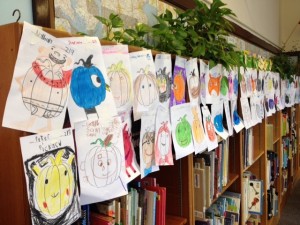 “Tailypo! Tailypo! All I want is my Tailypo!” Did your students come home singing this haunting tune? If so, they sat intently and listened to my not so frieghtening retelling of Tailypo by Jan Wahl. Often with themed readings I will take the opportunity to expose students to the same story presented in different mediums. Sadly I was unable to find a video of Tailypo that was appropriate for elementary ages students – ALL TOO SCARY! Of course telling students this before we read our story was the perfect hook to grab their undivided attention.
“Tailypo! Tailypo! All I want is my Tailypo!” Did your students come home singing this haunting tune? If so, they sat intently and listened to my not so frieghtening retelling of Tailypo by Jan Wahl. Often with themed readings I will take the opportunity to expose students to the same story presented in different mediums. Sadly I was unable to find a video of Tailypo that was appropriate for elementary ages students – ALL TOO SCARY! Of course telling students this before we read our story was the perfect hook to grab their undivided attention.
In addition, this week our literary pumpkins returned. Students were asked to decorate a pumpkin template from a book that they love. What a delight to have our library decorated with such creative student work!
23-25
Book Fair this week! Students are spending 1/2 of our library time checking out books and 1/2 of our time together browsing the selection of books brought to us by the University Bookstore.
In addition to our building hours, you can also shop online to support your Bagley Library. 25% of all sales go directly to adding books to our DBE Library.
Wednesday 10/23 – 3:30-6:30pm
Thursday 10/24 3:30-8:30pm (Literacy Night)
Friday 10/25 – 3:30-6:30pm
16-18
Using The Candy Shop War by Mull as our primary reference, we are continuing to explore what influences our choices as readers. We reviewed the Book
